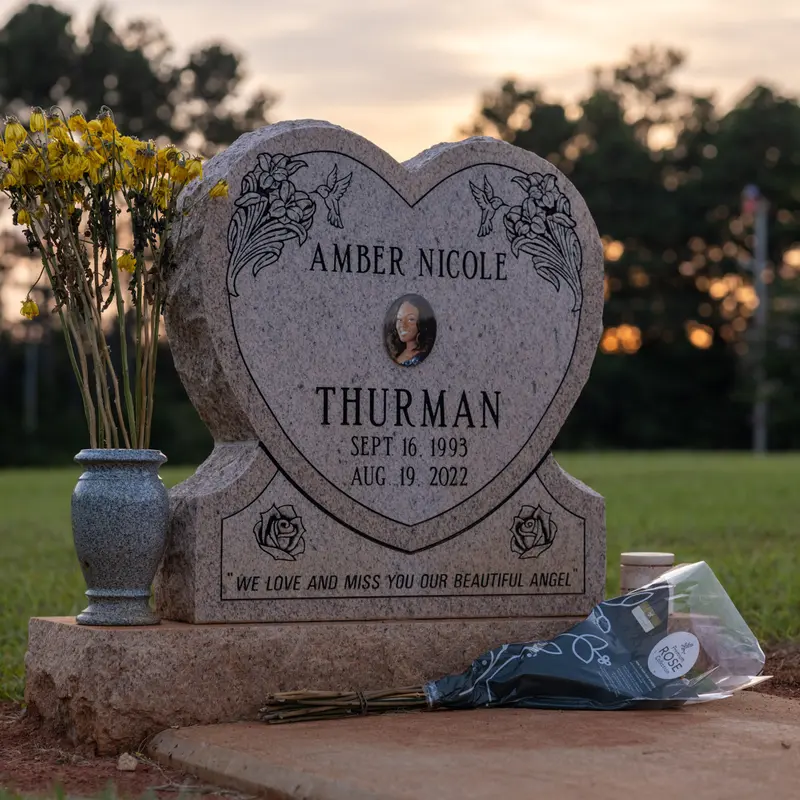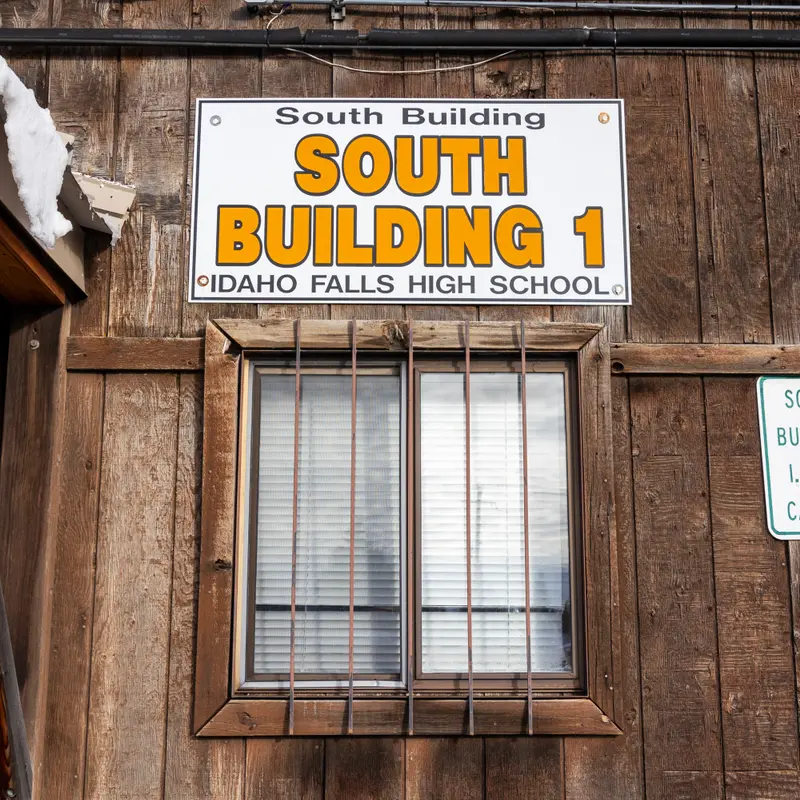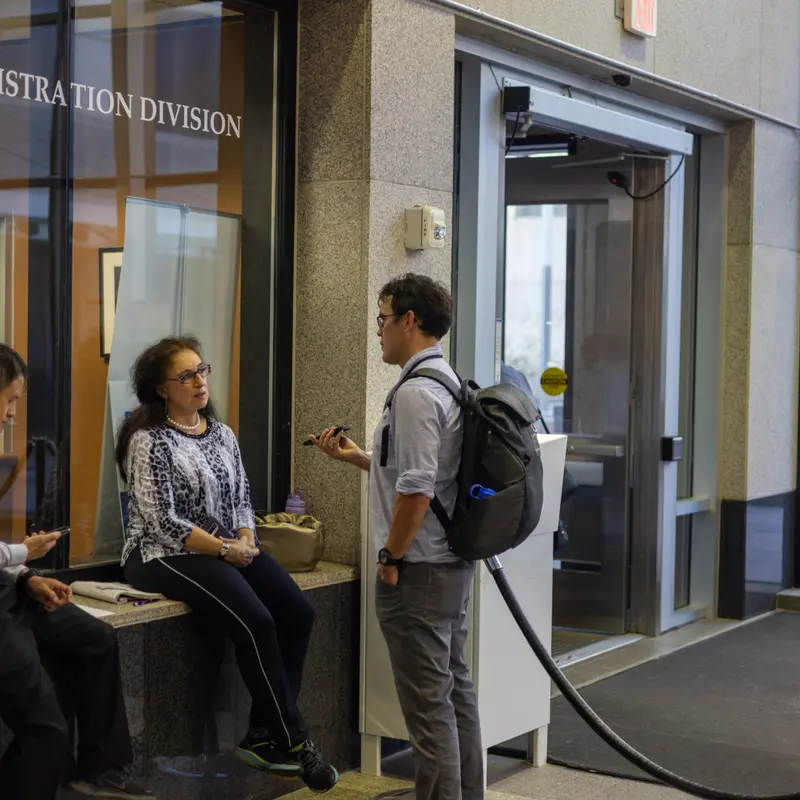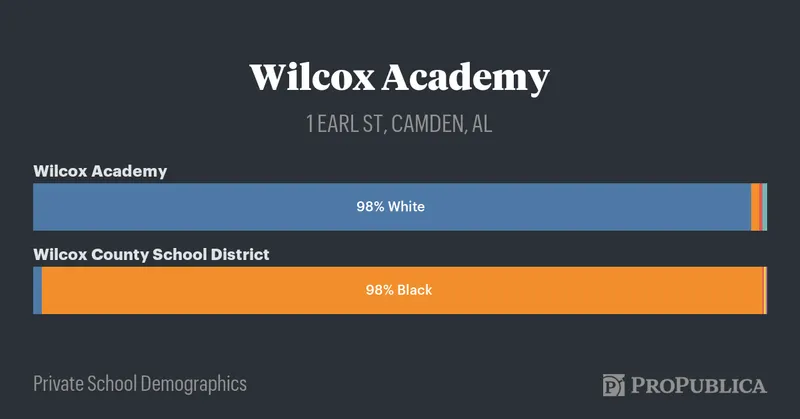How Segregated Are Your Local Private Schools? We Made a Tool to Help You Find Out.
Now you can look up detailed demographic information about thousands of private schools across the country and compare them to nearby public schools.
In South Carolina, where I live, rural towns often remain largely divided by race, especially those with larger Black communities. You’ll often hear people describe railroad tracks that run through these towns and how white people live on one side of the tracks, Black people on the other. That’s true. But I’ve often seen a different dividing line, a more impenetrable one. This one runs between schools: private and public ones.
While reporting in many of these small towns, I saw that Black children typically attend the local public schools while white kids head to private schools. Many of these private schools are known as “segregation academies” because they opened for white children while the federal courts were forcing districts across the South to desegregate. Hundreds of these academies still operate, and they continue to divide their communities.
When children don’t go to school together, they don’t interact much with peers of another race. Their parents don’t meet at the bus stop or at PTA meetings or on the sidelines of football games. Communities can remain almost as divided as they were before the U.S. Supreme Court ruled state-mandated school segregation was unconstitutional — 70 years ago.
I spent much of 2024 digging into “segregation academies” with my colleague, ProPublica research reporter Mollie Simon. Early on, we set out to compile a master list of segregation academies that are still operating, which we planned to use as a foundation for our reporting.
It’s difficult, impossible even, to identify these academies or even to understand local school segregation more broadly without knowing the racial makeup of each private school’s enrollment over time. And private schools aren’t always willing to hand over that information. Nor do they have to. But while putting together our list of segregation academies, we came across something incredibly useful — a 30-year trove of data kept by the U.S. Department of Education that lays out the story of racial segregation, school by school, across the country. It shows the racial breakdown of most private schools’ enrollments every other year since the early 1990s.
Outside of a handful of education researchers, the average person doesn’t know this data exists. Nor is most of it kept in an accessible format. Parents would need a high level of data literacy to use it to better understand education trends or to make their own school decisions.
Good journalism makes a difference:
Our nonprofit, independent newsroom has one job: to hold the powerful to account. Here’s how our investigations are spurring real world change:

Texas lawmakers pushed for new exceptions to the state’s strict abortion ban after we reported on the deaths of pregnant women whose miscarriages went untreated.

The Supreme Court created its first-ever code of conduct after we reported that justices repeatedly failed to disclose gifts and travel from the ultrawealthy.

The Idaho Legislature approved $2 billion for school repairs after we revealed just how poor the conditions were in the state’s crumbling schools.

The EPA proposed a ban on the toxic pesticide acephate after we highlighted the agency’s controversial finding that the bug killer doesn’t harm the developing brains of children.

Support ProPublica’s investigative reporting today.
We’re trying something new. Was it helpful?
ProPublica decided to create a Private School Demographics database, which we launched this week, that anyone, anywhere can use to look up a school and view the years of data we were relying on for our reporting.
The story behind this new tool began with our need to understand how many segregation academies still operate — and where. We wanted to focus only on those that continue to create segregating forces in their communities, not the ones whose student bodies had come to reflect their local areas.
We turned to the National Center for Education Statistics, which has demographic data about the students at most private schools in the country on its website. (Schools voluntarily reported their information to the center.) This was helpful, but it provided the racial breakdown of kids at each school only from the 2021-22 school year, the most recent data available.
We wanted to go back in time to see how the demographics of these schools have — or have not — changed over the years.
It turned out that this NCES data comes from something called the Private School Universe Survey, the dataset we came to rely on. It was practically hiding in plain sight.
While the most recent survey results are easily available on the NCES website, the rest are in formats that require experts to clean and organize into something usable. Luckily, we have those experts on our staff. Our colleagues Sergio Hernández and Nat Lash began digging into the older datasets, turning them into a searchable format. Then they compared each private school’s demographics to those of the public school district in which it is located.
This pointed us to illuminating stories about the effects of segregation academies in communities that weren’t on anyone’s radar, certainly not mine. In fact, the data could tell stories about myriad places all over the country where private schools educate millions of the nation’s children.
I used the database to point me to the segregation academies having the most dividing effects on their local communities. That led me first to a county in the rural shadow of Selma, Alabama, one of the most pivotal points on the Civil Rights movement’s map.
That community was 45 minutes to the south in Wilcox County, where I found people starkly divided by race, as they had been since the days when plantation operators hauled enslaved workers to the region to grow cotton. While Wilcox Academy was 98% white, the local county public schools were 98% Black. Local residents were dividing their scarce resources to operate two shrinking school systems, one private and one public — to the detriment of pretty much everyone there.

The story of Wilcox County formed the backbone of the first story in our segregation academy series.
Our database also steered me toward the last story in our series, this one based in Mississippi’s Amite County, where we found segregation academies that had some of the most profoundly dividing effects yet. One of them had never reported enrolling more than a single Black student at a time. The other had just hit an all-time high — 3.5% Black enrollment in a county where almost 40% of residents are Black.
Perhaps the most telling detail didn’t come from the data or our master list. I found it at a Friday night football game. One night while I was in Amite, the public high school played a home game — and so did the nearby academy. While the public high school played, its stands full of Black families, I interviewed a Black man who had graduated from the public high school and coached its football team.
As halftime neared, he and I decided to head over to the private school, a segregation academy just over the tree line. Over all his years living and working in this community, he had never stepped foot on the campus. Almost everyone there — people from this very small community — was white. But he recognized only a few of them.
As we walked toward the stands, he described feeling a million eyes on him. Nobody was unfriendly. But this threshold felt far more impenetrable than any railroad tracks I had ever encountered.
ProPublica is a nonprofit newsroom that investigates abuses of power. Sign up for Dispatches, a newsletter that spotlights wrongdoing around the country, to receive our stories in your inbox every week.
ProPublica is a nonprofit newsroom that investigates abuses of power. Sign up for Dispatches, a newsletter that spotlights wrongdoing around the country, to receive our stories in your inbox every week.







